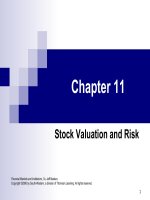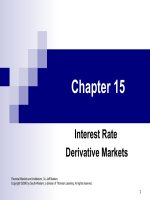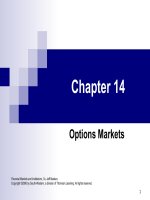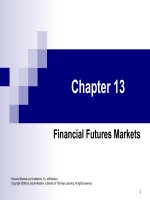Tài liệu Thị trường tài chính và các định chế tài chính_ Chapter 16 pptx
Bạn đang xem bản rút gọn của tài liệu. Xem và tải ngay bản đầy đủ của tài liệu tại đây (321.02 KB, 38 trang )
1
Chapter 16
Foreign Exchange
Derivative Markets
Financial Markets and Institutions, 7e, Jeff Madura
Copyright ©2006 by South-Western, a division of Thomson Learning. All rights reserved.
2
Chapter Outline
Background on foreign exchange markets
Factors affecting exchange rates
Movements in exchange rates
Forecasting exchange rates
Forecasting exchange rate volatility
Speculation in foreign exchange markets
Foreign exchange derivatives
International arbitrage
Explaining price movements of foreign exchange
derivatives
3
Background on Foreign Exchange
Markets
Foreign exchange markets consist of a global
telecommunications network among large commercial
banks that serve as financial intermediaries
Banks are located in New York, Tokyo, Hong King, Singapore,
Frankfurt, Zurich, and London
The bid price is always lower than the ask price
Institutional use of foreign exchange markets
The degree of international investment by financial institutions is
influenced by potential return, risk, and government regulations
Institutions are increasing their use of the foreign exchange
markets because of reduced information and transaction costs
4
Background on Foreign Exchange
Markets (cont’d)
Financial
Institution
Participation in Foreign Exchange Market
Commercial
banks
Serve as financial intermediaries in the foreign exchange market by
buying or selling currencies
Speculate on foreign currency movements by taking long positions
in some currencies and short positions in others
Provide forward contracts to customers
Offer currency options to customers, which can be tailored to a
customer’s specific needs
International
mutual funds
Use foreign exchange markets to exchange currencies when
reconstructing their portfolios
Use foreign exchange derivatives to hedge a portion of their
exposure
Brokerage firms
and investment
banking firms
Engage in foreign security transactions for their customers or for
their own accounts
5
Background on Foreign Exchange
Markets (cont’d)
Financial
Institution
Participation in Swap Market
Insurance
companies
Use foreign exchange markets when exchanging currencies for their
international operations
Use foreign exchange markets when purchasing foreign securities
for their investment portfolios or when selling foreign securities
Use foreign exchange derivatives to hedge a portion of their
exposure
Pension funds
Require foreign exchange of currencies when investing in foreign
securities for their stock or bond portfolios
Use foreign exchange derivatives to hedge a portion of their
exposure
6
Background on Foreign Exchange
Markets (cont’d)
Exchange rate quotations
The spot exchange rate is for immediate
delivery
Forward rates indicate the rate at which a
currency can be exchanged in the future
Cross-exchange rates
Some quotations express the exchange rate
between two non-dollar currencies
7
Computing A Cross-Exchange
Rate
The euro is worth $1.15, and the Canadian dollar
is worth $0.60. What is the value of the euro in
Canadian dollars?
92.1$C60.0$/15.1$C$ in euro of Value ==
8
Background on Foreign Exchange
Markets (cont’d)
Types of exchange rate systems
1944 to 1971: the exchange rate at which one currency
could be exchanged for another was maintained within
1 percent of a specified rate (the Bretton Woods era)
1971: an agreement among major countries
(Smithsonian Agreement) allowed for devaluation of
the dollar and a widening of the boundaries to 2.25%
1973: boundaries were eliminated and exchange rates
of major countries were allowed to float
Dirty float
Freely floating system
9
Background on Foreign Exchange
Markets (cont’d)
Types of exchange rate systems (cont’d)
Pegged exchange rate systems
Some currencies may be pegged to another
currency or a unit of account and maintained within
specified boundaries
ERM until 1999
Hong Kong since 1983
Argentina from 1991 until 2002
A country that pegs its currency does not have
complete control over its local interest rates
10
Background on Foreign Exchange
Markets (cont’d)
Types of exchange rate systems (cont’d)
Classification of exchange rate arrangements
Many countries allow the value of their currency to
float against others, but governments intervene
periodically to influence its value
Many governments attempt to impose exchange
controls to prevent their exchange rate from
fluctuating
When controls are removed, the exchange rate abruptly
adjust to a new market-determined level
11
Factors Affecting Exchange Rates
The value of a currency adjusts to changes in
demand and supply
In equilibrium, there is no excess or deficiency of that
currency
If a currency increases in value, it appreciates
If a currency decreases in value, it depreciates
Exchange rates are influenced by:
Differential inflation rates
Differential interest rates
Government intervention
12
Factors Affecting Exchange Rates
(cont’d)
Differential inflation rates
Purchasing power parity (PPP) suggests that the exchange rate
will change by a percentage that reflects the inflation differential
between the two countries of concern
Differential interest rates
Interest rate movements affect exchanges rates by influencing the
capital flows between countries
Central bank intervention
Central banks attempt to adjust a currency’s value to influence
economic conditions
Direct intervention occurs when a country’s central bank sells
some of its currency reserves for a different currency
13
Factors Affecting Exchange Rates
(cont’d)
Indirect intervention
The Fed can affect the dollar’s value indirectly by influencing the
factors that determine its value
e.g., the Fed can attempt to lower interest rates by increasing the
money supply, which puts downward pressure on the dollar
Indirect intervention during the Peso Crisis
The central bank increased interest rates to discourage foreign
investors from withdrawing their investments in Mexico’s debt
securities
Indirect intervention during the Asian Crisis
Some Asian countries increased their interest rates to encourage
investors to leave their funds in Asia
Indirect intervention during the Russian crisis
The Russian central bank attempted to prevent outflows by tripling
interest rates
14
Factors Affecting Exchange Rates
(cont’d)
Foreign exchange controls
Controls, such as restrictions on the exchange
of a currency, can be used as a form of
indirect intervention
e.g., Venezuela imposed foreign exchange controls
in the mid-1990s
Under severe pressure, governments tend to
let the currency float temporarily toward its
market-determined level
15
Forecasting Exchange Rates
Market participants take derivative positions based on
their expectations of future exchange rates
Technical forecasting involves the use of historical
exchange rate data to predict future values
e.g., time-series models that examine moving averages and
allow the forecaster to develop some rule
Fundamental forecasting is based on fundamental
relationships between economic variables and exchange
rates
e.g., high inflation in a country can lead to depreciation in its
currency









